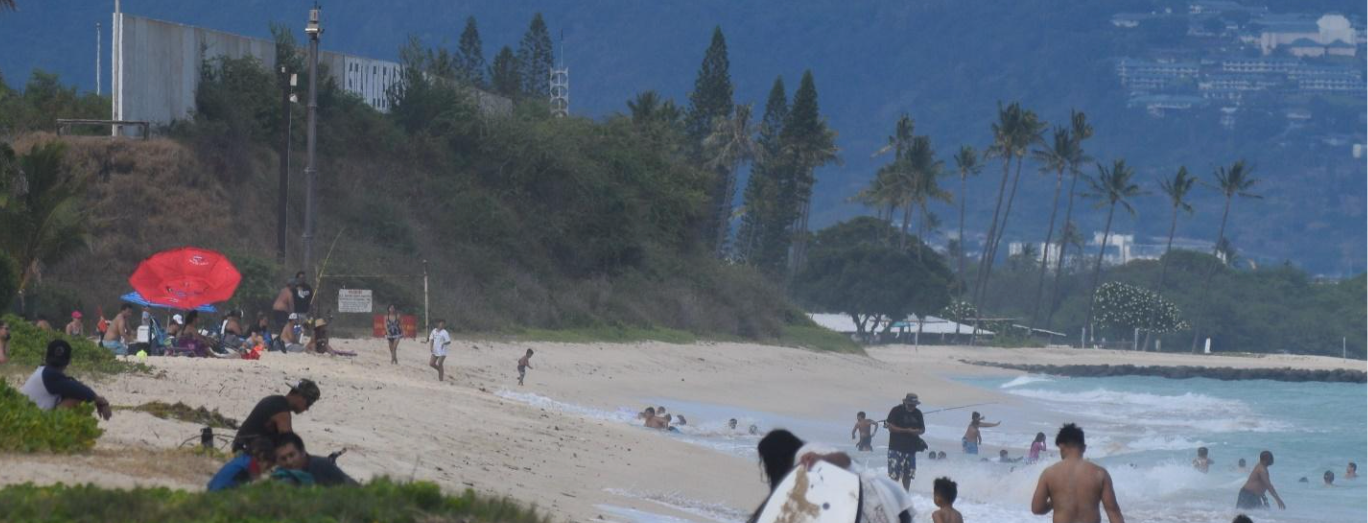
10.12.22
Oʻahu Chapter Releases Report to Warn Public of High Lead Contamination at ʻEwa Beach in Pu'uloa
By Mara DiasSurfrider Foundation Oʻahu & local community demand the Navy protect local communities and coastal ecosystems along the Puʻuloa coastline from lead contamination.
With the release of their Pu'uloa Beach Lead Contamination Report, the Oʻahu Chapter of the Surfrider Foundation has launched a new campaign and has earned massive media coverage of dangerous lead contamination of the Pu'uloa shoreline and ʻEwa Beach. This beach is located right next to a firearms training facility used by the Navy, but is favored by local families and community members as a recreational beach. The Chapter and the local community are now asking the Navy to take action to clean up this contamination to protect public health and to prevent any further contamination from occurring. They are also looking forward to additional testing being performed by the Hawai'i Department of Health that will provide further information on the extent of the contamination and the remediation needed.
Check out this great newsclip of Surfrider Foundation Oʻahu volunteer and local resident Mike Plowman that aired on KITV News 4 to learn more about this issue. A press release announcing Surfrider Oʻahu's report follows.
ʻEWA BEACH, HAWAII – In January and February 2022, Surfrider Foundation Oʻahu Chapter (SFO) obtained samples of the sandy soils from the oceanside of impact berms and the beach area directly seaward of the Puʻuloa Range Training Facility (PRTF) in ʻEwa Beach. These areas are vulnerable to coastal erosion. The samples were tested by Hawaiʻi Analytical Laboratories, LLC. The results show lead concentrations of up to 14,000 mg/kg - over 17 times the accepted public health levels for industrial areas and 70 times the accepted level for residential areas. The Hawai’i Hazard Evaluation and Emergency Response (HEER) Office has established a lead standard of 200 mg/kg in residential areas and 800 mg/kg in industrial areas.
“These high lead concentrations are extremely concerning,” said Keili McEvilly, Surfrider Foundation Oʻahu Chapter Coordinator. “This is a public health issue for all beachgoers and ocean users as well as a threat to the coastal environment.”
For over a century, PRTF has been used as a rifle and pistol range. The impact berms at PRTF run adjacent to the beach and now have high levels of lead from the bullets fired at them. The highly contaminated soils at PRTF are cause for concern, especially due to the proximity of public recreational areas, Oahu’s EPA designated Sole Source Aquifer, the City and County of Honolulu’s (CCH) Puʻuloa Beach Park, residential neighborhoods on either side of the firing range, and the fragile coral reef ecosystem. The contaminated soils Surfrider documented seaward of the PRTF are currently exposed to coastal erosion and may migrate into the reef ecosystem or longshore to the highly used public areas. Families either live in or visit these areas each day and many children may be exposed to severely dangerous levels of contamination.
As immediate steps to address the extremely high levels of lead, SFO requests that the Navy do the following:
- Clean up any lead-contaminated soil on, seaward of, and adjacent to the PRTF.
- Sample the soils and water at the Puʻuloa Beach Park and within the nearby residential neighborhoods of ʻEwa Beach and Iroquois Point.
- Sample the reef ecosystem seaward of PRTF for lead contamination.
In the long-term, SFO asks the Navy to:
- Relocate all of the PRTF impact berms away from the sensitive coastal environment.
- Conduct more frequent lead remediation of berms.
- Incorporate quantitative soil testing into the REVA program.
“After years of neglect, these soils are a health hazard - especially to children who frequently play in what may be polluted areas,” said SFO Chair, Elizabeth Benychek. “We have a responsibility to protect this place and future generations.”
To keep up with this campaign visit Surfrider Foundation Oʻahu's website. Read the full Pu'uloa Beach Lead Contamination Report here.